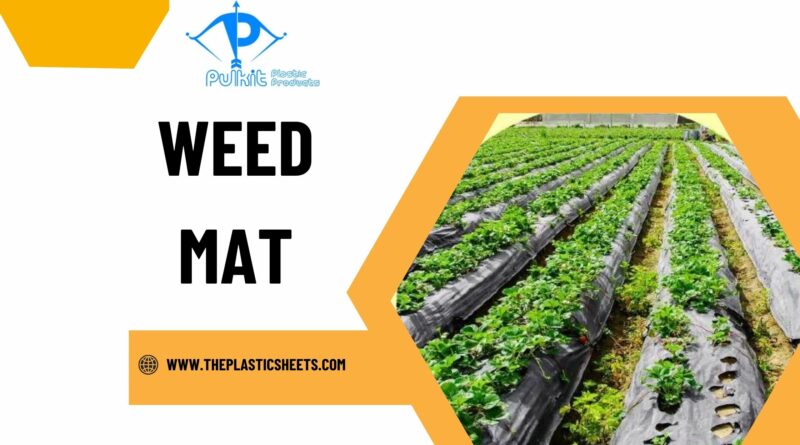The Ultimate Guide to Weed Mats: A Natural Solution for Weed Control
Managing an outdoor space, whether it’s a garden, a lawn, or a larger agricultural area, often comes with its share of challenges—one of the biggest being the control of weeds. Weeds compete with your plants for nutrients, water, and sunlight, making them a nuisance for gardeners and farmers alike. Fortunately, using weed mats has emerged as a practical and effective solution for weed control, allowing for a healthier growing environment without the constant labor of hand weeding or the application of harsh chemicals. In this comprehensive guide, we’ll delve into the world of weed mats, their benefits, types, installation, and maintenance, providing you with all the information you need to make an informed decision.
What is a Weed Mat?
A weed mat, also known as a Weed Prevention Mat or weed suppressing mat, is a piece of material placed on the ground to suppress weed growth while allowing water, air, and nutrients to reach the soil. Made from various materials—both natural and synthetic—weed mats work by blocking sunlight from reaching weed seeds and seedlings, effectively preventing their growth.
Benefits of Using Weed Mats
- Effective Weed Control: The primary purpose of a weed mat is to prevent weeds from germinating and growing, significantly reducing competition for your plants.
- Reduced Labor: Once installed, weed mats require minimal maintenance compared to traditional weeding methods, saving you time and effort.
- Soil Temperature Regulation: Weed mats can help maintain consistent soil temperatures, promoting a healthier environment for plant roots.
- Moisture Retention: By covering the soil, weed mats reduce evaporation, which helps retain moisture in the ground, benefitting plants during dry spells.
- Environmentally Friendly: Many weed mats are made from biodegradable materials, making them a sustainable choice for gardeners looking to minimize their environmental impact.
- Improved Soil Health: By creating a barrier, weed mats can help prevent soil erosion and promote a healthy ecosystem within your garden.
Types of Weed Mats
There are several different types of weed mats available, each catering to different gardening needs:
1. Synthetic Weed Mats
These mats are made from materials like polypropylene or polyethylene. They are durable and provide long-lasting weed control. However, while they can be effective, they may not be biodegradable and can contribute to plastic waste in the environment.
2. Organic or Biodegradable Weed Mats
Made from natural materials, organic weed mats can include jute, burlap, or cardboard. They decompose over time, enriching the soil as they break down. While they may require more frequent replacement than synthetic options, they are ideal for those looking for environmentally friendly solutions.
3. Landscape Fabric Mats
Weed Matting Fabric often made from light-weight geotextiles, is designed specifically for weed control without impeding water and nutrient flow. They are perforated to allow air, water, and nutrients to reach the soil, making them suitable for use under mulch or decorative stones.
4. Mulch Mats
These Weed Suppressing Mat are a combination of mulch and weed suppression. They often consist of organic materials such as wood chips or shredded bark, which not only suppress weeds but also enhance soil health as they decompose.
Installation of Weed Mats
Implementing weed mats in your garden or growing area is straightforward. Here’s a step-by-step guide to help you get started:
Step 1: Preparation
- Clear the Area: Begin by removing any existing weeds, grass, or debris from the area where you plan to install the weed mat.
- Level the Soil: Rake and level the soil to ensure an even surface for the weed mat.
Step 2: Install the Mat
- Cut to Size: Measure the area and cut the weed mat to fit your specific requirements.
- Lay the Mat: Place the weed mat directly onto the soil, ensuring it covers all exposed areas. If using landscape fabric, allow it to overlap at the edges to prevent weeds from sprouting through.
Step 3: Securing the Mat
- Anchor the Mat: Use landscape fabric staples or weights to secure the weed mat in place, especially in windy areas or locations with heavy rainfall.
- Mulch (Optional): For added protection and aesthetics, you can cover the weed mat with mulch. This can also help to suppress any remaining weed seeds that might have been disturbed during soil preparation.
Step 4: Regular Maintenance
- Inspect the area periodically to ensure that the weed mat remains intact. If you notice any damages, repair or replace the affected areas.
- Refresh the mulch layer annually to keep the aesthetic appeal of your garden and provide additional weed suppression.
Maintenance of Weed Mats
While weed mats require minimal maintenance, there are still a few key tasks to keep in mind:
- Check for Weeds: Though highly effective, some weeds might still emerge from the edges or through damaged areas of the mat. Regularly inspect the garden to remove any weeds that do appear.
- Replace as Needed: Depending on the type of mat used, be prepared to replace or refresh it periodically. Organic mats will decompose over time, while synthetic options can sometimes be damaged by UV light.
- Monitoring Soil Health: If using biodegradable mats, observe how they influence soil health over time. They should decompose to enrich the soil as long as other conditions are favorable.
Conclusion
Weed mats present a natural, effective solution for controlling weeds in your garden or agricultural space. By choosing the right type of weed mat and following proper installation and maintenance procedures, you can create a healthier growing environment for your plants. Whether you opt for synthetic options for longevity or biodegradable choices for sustainability, the advantages of using weed mats are undeniable. With the guidance provided in this article, you are now equipped to make the best choice to meet your weed control needs. Investing in weed mats offers the promise of a thriving garden—one where your plants can flourish without the constant battle against invasive weeds.
You can find a variety of weed mats at garden centers, home improvement stores, or online. Pulkit Plastic Products offers a range of high-quality weed prevention mats, weed matting fabric, and weed suppressing mats suitable for various applications.
FAQs About Weed Mats
Q1: How long do weed mats last?
The lifespan of weed mats depends on the material used. Synthetic weed mats can last several years, while biodegradable mats may need replacement every year or two, depending on environmental conditions.
Q2: Can I use weed mats in vegetable gardens?
Yes, weed mats can be used in vegetable gardens. Just ensure that the chosen mat allows sufficient water and air flow to the soil and is made from food-safe materials.
Q3: Do I need to remove existing weeds before installing a weed mat?
Yes, it’s essential to remove all existing weeds and debris before installing a weed mat. This will allow the mat to work effectively and prevent any disturbance to new seedlings.
Q4: Will a weed mat prevent all types of weeds?
While weed mats are effective at suppressing many types of weeds, some resilient varieties may survive. Regular inspection for any unexpected growth is advisable.
Q5: Which type of weed mat is best for my garden?
The choice of weed mat depends on your specific gardening needs. Synthetic mats are durable and long-lasting, while biodegradable mats are better for eco-conscious gardeners looking for natural solutions.
Q6: How do I clean and maintain weed mats?
Cleaning weed mats generally involves removing any debris and seasonal checks for damages. You may rinse off any accumulated dirt, but avoid using harsh chemicals.




